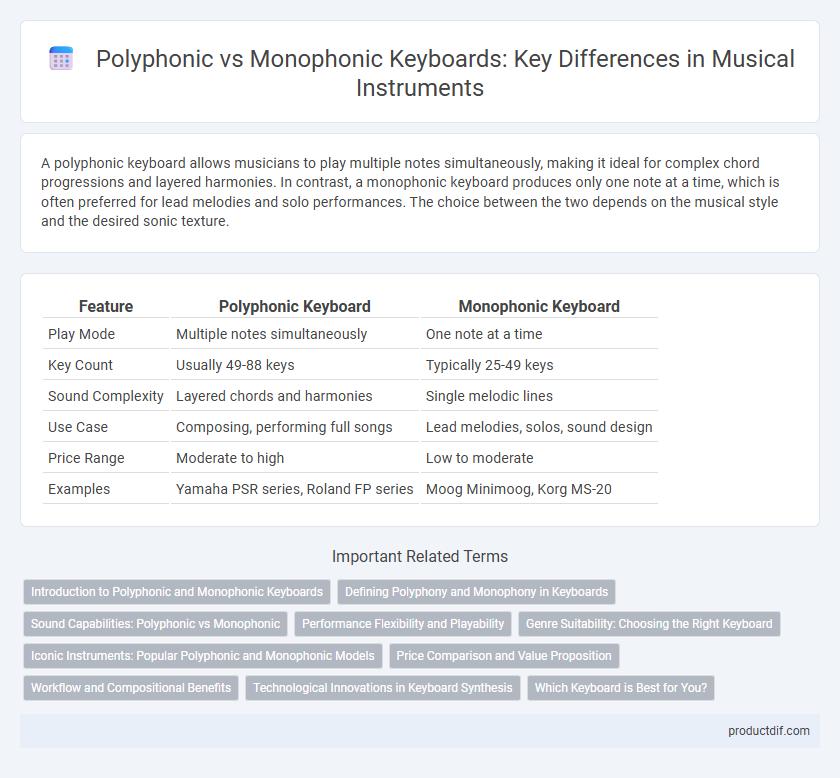A polyphonic keyboard allows musicians to play multiple notes simultaneously, making it ideal for complex chord progressions and layered harmonies. In contrast, a monophonic keyboard produces only one note at a time, which is often preferred for lead melodies and solo performances. The choice between the two depends on the musical style and the desired sonic texture.
Table of Comparison
| Feature | Polyphonic Keyboard | Monophonic Keyboard |
|---|---|---|
| Play Mode | Multiple notes simultaneously | One note at a time |
| Key Count | Usually 49-88 keys | Typically 25-49 keys |
| Sound Complexity | Layered chords and harmonies | Single melodic lines |
| Use Case | Composing, performing full songs | Lead melodies, solos, sound design |
| Price Range | Moderate to high | Low to moderate |
| Examples | Yamaha PSR series, Roland FP series | Moog Minimoog, Korg MS-20 |
Introduction to Polyphonic and Monophonic Keyboards
Polyphonic keyboards enable the simultaneous playing of multiple notes, allowing for richer and more complex musical textures compared to monophonic keyboards, which produce only one note at a time. Polyphonic capability is essential for chords, harmonies, and layered sounds, making it a preferred choice for advanced compositions and performances. In contrast, monophonic keyboards are often used in lead melodies, solos, and sound design due to their simplicity and focus on single-note expression.
Defining Polyphony and Monophony in Keyboards
Polyphony in keyboards refers to the ability to play multiple notes simultaneously, allowing for complex chords and layered sound textures, essential for piano and organ playing. Monophony, on the other hand, restricts the player to one note at a time, typical of early synthesizers and certain wind controllers. The distinction between polyphonic and monophonic keyboards fundamentally impacts musical expression and arrangement capabilities in electronic and acoustic instruments.
Sound Capabilities: Polyphonic vs Monophonic
Polyphonic keyboards can produce multiple notes simultaneously, enabling complex chords and rich harmonic textures essential for genres like jazz and classical. Monophonic keyboards restrict sound output to one note at a time, making them ideal for lead melodies and basslines where single-note clarity is crucial. The sound capabilities of polyphonic keyboards offer greater versatility in layering sounds, while monophonic models excel in expressive, nuanced solo performances.
Performance Flexibility and Playability
Polyphonic keyboards enable simultaneous playing of multiple notes, offering greater performance flexibility for complex chords and harmonies, while monophonic keyboards are limited to single-note melodies. Playability on polyphonic keyboards supports diverse musical styles and intricate arrangements, enhancing expressive capabilities. Monophonic keyboards, favored in lead synth lines, provide simplicity and precision but restrict layering and texture variety.
Genre Suitability: Choosing the Right Keyboard
Polyphonic keyboards excel in genres like jazz, classical, and electronic music where multiple notes and complex harmonies are essential, offering greater versatility for intricate compositions. Monophonic keyboards suit styles such as lead synth lines in genres like techno, hip-hop, and blues where single-note expression and modulation dominate. Selecting between polyphonic and monophonic keyboards depends on the musical genre's demand for either rich harmonic layering or focused melodic articulation.
Iconic Instruments: Popular Polyphonic and Monophonic Models
Iconic polyphonic keyboards like the Yamaha DX7 and Roland Juno-106 revolutionized music production with their ability to play multiple notes simultaneously, enabling rich, layered sounds. In contrast, monophonic models such as the Minimoog Model D and ARP Odyssey excelled in delivering powerful, expressive solos by restricting output to a single note at a time. These classic instruments continue to influence modern synthesizer design and musical genres, highlighting their enduring legacy in electronic music.
Price Comparison and Value Proposition
Polyphonic keyboards generally command higher prices than monophonic keyboards due to their ability to produce multiple simultaneous notes, enhancing versatility for complex compositions. Monophonic keyboards, often more affordable, appeal to beginners and electronic musicians seeking straightforward, single-note play, offering strong value at a lower cost. Investing in a polyphonic model suits professional musicians prioritizing rich soundscapes, while monophonic versions provide cost-effective options for simple melodic experimentation.
Workflow and Compositional Benefits
Polyphonic keyboards enable simultaneous playing of multiple notes, enhancing workflow by allowing complex chord progressions and layered textures within compositions. Monophonic keyboards limit input to one note at a time, simplifying melodic lines but restricting harmonic depth and real-time arrangement capabilities. Composers benefit from polyphonic keyboards by efficiently exploring intricate harmonies and dynamic interplay, which accelerates creative experimentation and enriches musical expression.
Technological Innovations in Keyboard Synthesis
Polyphonic keyboards utilize advanced digital signal processing and multiple oscillators to produce several independent notes simultaneously, enhancing harmonic richness and complexity in performances. Monophonic keyboards, limited to single-note output, often incorporate sophisticated envelope generators and filter modulations to shape individual tones with greater expressiveness. Innovations such as velocity-sensitive keys, aftertouch, and integrated MIDI capabilities have propelled both polyphonic and monophonic keyboards into versatile instruments essential for modern electronic music production.
Which Keyboard is Best for You?
Choosing between a polyphonic keyboard and a monophonic keyboard depends on your musical goals and style. Polyphonic keyboards allow multiple notes to be played simultaneously, making them ideal for complex compositions and chord progressions, while monophonic keyboards produce one note at a time, offering clarity and precision for lead melodies and basslines. Evaluate your preference for layered sounds or single-note expression to determine which keyboard suits your creative needs best.
Polyphonic keyboard vs Monophonic keyboard Infographic

 productdif.com
productdif.com